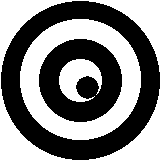The following general directions apply to the execution of all the steps used in the Country Dance:-
- Country Dance steps always fall on the main divisions of the bar, i.e., on each of the two beats in duple measure (2/2 or 6/8), and of the three beats in triple measure (3/2 or 9/8). In the case of a compound step, that is, one that comprises more than one movement, the accented movement should fall on the beat.
- The step should fall on the ball of the foot, not on the toe, with the heel off, but close to, the ground.
- The feet should be held straight and parallel, neither turned out nor in at the ankle.
- The legs should never be straddled, but held close together. Nor again should they be extended more than is absolutely necessary; the spring should as far as possible take the place of the stride.
- The jar caused by the impact of the feet on the floor should be absorbed mainly by the ankle-joint, and very little, or not all by the knees. The knee should be bent as little as possible, so little that the supporting leg should appear to be straight, i.e., in one line from hip to ankle.
- All unnecessary movements should be suppressed, e.g., kicking up the heels, fussing with the feet, raising the knees, etc.
THE RUNNING STEP.
This is the normal Country Dance step. It is an ordinary running-step, executed neatly and lightly, in accordance with the above instructions.
In the notation this will be marked:-
r.s. (running step).
THE WALKING STEP.
This is a modified form of the running-step, in which the spring, though present, is scarcely noticeable.
In the notation this will be marked:-
w.s. (walking step).
SKIPPING-STEP.
This is the usual step-and-hop on alternate feet. The accent is on the step, which must
fall, therefore, on the beat. Care should be taken to prevent the skipping-step from
degenerating into a double-hop, the two feet taking the ground together, instead of in
succession. The hop should fall on the last quarter, or last third, of the beat according
as the latter is simple or compound, thus:-
In the notation this will be marked:-
sk.s. (skipping-step).
SLIPPING-STEP
This is a series of springs, made sideways, off alternate feet, the major spring being on the outside foot, i.e., the left when going to the left and the right when going to the right. Although the legs are thus alternately opening and closing, scissor-fashion, the motion is effected almost wholly by the spring, not the straddle; the legs, therefore, should be separated as little as possible. The free foot should not be allowed to scrape along the ground.
The accent falls on the foot on to which the major spring is made, that is, the left or
right, according to the direction of motion, thus:-
In the notation this will be marked:-
sl.s (slipping step).
THE DOUBLE-HOP.
This is sometimes, though very rarely, used in ring movements as an alternative to the slipping-step. It is a variant of the Slip, in which the feet, instead of taking the ground separately one after the other, alight together a few inches apart.
THE SINGLE.
Playford defines the Single as "two steps, closing the feet." Technically this may be interpreted in the following way: on the first beat of the bar a spring is made, forwards or sideways, on to one foot, say the right; the left foot is then brought up beside it, the weight wholly or in part momentarily supported upon it, and, on the second beat of the bar, transferred to the right foot in position.This step is subject to various modifications, partly individual, but more often arising from the character of the dance or phrase in which the step occurs. Many dancers, for instance, never allow the foot on which the initial spring is made (i.e., the right foot in the above description) to leave the ground when the left foot is bought up beside it; but instead, rise on the toes of both feet on the intermediate accent, and then on the second beat fall back on to the ball of the right foot.
THE DOUBLE.
This is defined in The English Dancing Master as "four steps forward or backward closing the feet," i.e., four running or walking steps, the last of which is made in position (that is, beside the other foot), the weight being supported on one foot or other, according to circumstances.
THE TURN SINGLE.
The dancer makes a whole turn on his axis, clockwise (unless otherwise directed), taking four (in triple measure, three or six) low springing steps off alternate feet, beginning with the right foot. The body must be held erect, and the turn regulated so that the dancer completes the circle and regains his original position on the last step.
In the notations specific steps are sometimes prescribed, but these are not to be regarded as obligatory. When no directions are given the choice of step must be determined by the performers themselves. In such cases dancers should remember (1) that the running-step is the normal Country Dance step, and that it is only in comparatively few cases that any other step can effectively be substituted for it; (2) that slipping and skipping steps, being compound steps, occupy more time in their execution than the "simple" running-step, and should not therefore be used except in dances of slow or moderate time; (3) that it is not necessary for every dancer to use the same step at the same time; nor, again, is it necessary (4) that a single figure should always be danced to one step throughout - the arbitrary change of step in the course of a movement is not only permissible, but is in many cases to be commended.
Page transcribed by Hugh Stewart
